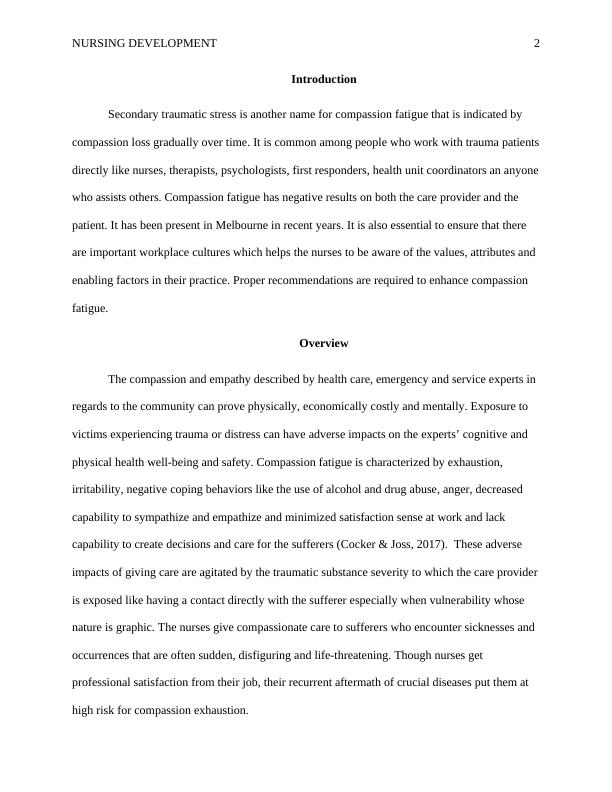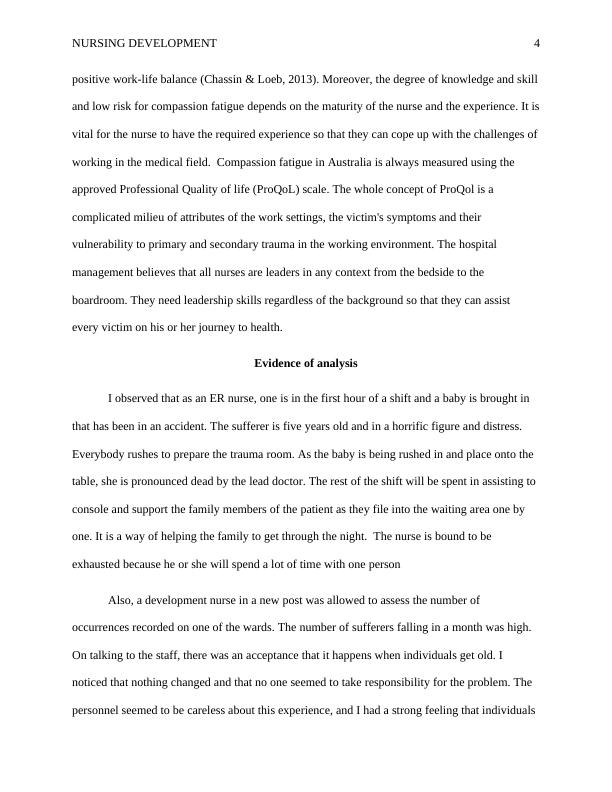Compassion Fatigue in Nursing Practice: Workplace Culture and Enabling Factors
Added on 2023-06-05
16 Pages4448 Words434 Views
Running Head: NURSING DEVELOPMENT 1
Nursing Development
Name
Professor
Institutional Affiliation
Nursing Development
Name
Professor
Institutional Affiliation

NURSING DEVELOPMENT 2
Introduction
Secondary traumatic stress is another name for compassion fatigue that is indicated by
compassion loss gradually over time. It is common among people who work with trauma patients
directly like nurses, therapists, psychologists, first responders, health unit coordinators an anyone
who assists others. Compassion fatigue has negative results on both the care provider and the
patient. It has been present in Melbourne in recent years. It is also essential to ensure that there
are important workplace cultures which helps the nurses to be aware of the values, attributes and
enabling factors in their practice. Proper recommendations are required to enhance compassion
fatigue.
Overview
The compassion and empathy described by health care, emergency and service experts in
regards to the community can prove physically, economically costly and mentally. Exposure to
victims experiencing trauma or distress can have adverse impacts on the experts’ cognitive and
physical health well-being and safety. Compassion fatigue is characterized by exhaustion,
irritability, negative coping behaviors like the use of alcohol and drug abuse, anger, decreased
capability to sympathize and empathize and minimized satisfaction sense at work and lack
capability to create decisions and care for the sufferers (Cocker & Joss, 2017). These adverse
impacts of giving care are agitated by the traumatic substance severity to which the care provider
is exposed like having a contact directly with the sufferer especially when vulnerability whose
nature is graphic. The nurses give compassionate care to sufferers who encounter sicknesses and
occurrences that are often sudden, disfiguring and life-threatening. Though nurses get
professional satisfaction from their job, their recurrent aftermath of crucial diseases put them at
high risk for compassion exhaustion.
Introduction
Secondary traumatic stress is another name for compassion fatigue that is indicated by
compassion loss gradually over time. It is common among people who work with trauma patients
directly like nurses, therapists, psychologists, first responders, health unit coordinators an anyone
who assists others. Compassion fatigue has negative results on both the care provider and the
patient. It has been present in Melbourne in recent years. It is also essential to ensure that there
are important workplace cultures which helps the nurses to be aware of the values, attributes and
enabling factors in their practice. Proper recommendations are required to enhance compassion
fatigue.
Overview
The compassion and empathy described by health care, emergency and service experts in
regards to the community can prove physically, economically costly and mentally. Exposure to
victims experiencing trauma or distress can have adverse impacts on the experts’ cognitive and
physical health well-being and safety. Compassion fatigue is characterized by exhaustion,
irritability, negative coping behaviors like the use of alcohol and drug abuse, anger, decreased
capability to sympathize and empathize and minimized satisfaction sense at work and lack
capability to create decisions and care for the sufferers (Cocker & Joss, 2017). These adverse
impacts of giving care are agitated by the traumatic substance severity to which the care provider
is exposed like having a contact directly with the sufferer especially when vulnerability whose
nature is graphic. The nurses give compassionate care to sufferers who encounter sicknesses and
occurrences that are often sudden, disfiguring and life-threatening. Though nurses get
professional satisfaction from their job, their recurrent aftermath of crucial diseases put them at
high risk for compassion exhaustion.

NURSING DEVELOPMENT 3
Nursing practice in Melbourne has shown compassion fatigue in recent years. Moreover,
the nurses have been exposed to adverse conditions especially in the hospital emergency
departments and intensive care units. Furthermore, despite the technological use in hospitals, the
nurses are outnumbered by the patients hence they become exhausted. Additionally, there is an
intense workload and short rest time periods between shifts, repeating tasks, poor resilience, lack
of meaningful recognition and lack of support from the management (American Nurses
Association, 2015). As a result, healthcare managers and employers have very little conclusive
evidence to prevent compassion fatigue. Studies have indicated that emotional intellectual and
physical effects of giving expertise services have been addressed by focusing on the
identification the prevalence and predictors of compassion fatigue in a specialized occupational
team like nurses and community health experts.
Patient-centered nursing in intensive care differs from other healthcare departments. This
critical setting and challenges faced by nurses have turned out to compromise the capability of
providing effective patient-centered nursing. Critical care health experts have compassion
satisfaction and fatigue mid-range levels. The working environment, training, maturity, and
experience also have an implication on the level of compassion satisfaction and exhaustion.
Nurses remain in their role as health care givers despite the high levels of compassion fatigue
(Boyle, 2011).
Research has shown that the nurses also get a sense of compassion satisfaction that is
known as the absolute feels received from assisting others through experiences that are
traumatic. Supportable professional quality of life is attained by sustaining a healthy balance
between the good and bad caring aspects. The balance place between compassion satisfaction
and compassion fatigue must be attained in the workplace and encouraging the essentiality of a
Nursing practice in Melbourne has shown compassion fatigue in recent years. Moreover,
the nurses have been exposed to adverse conditions especially in the hospital emergency
departments and intensive care units. Furthermore, despite the technological use in hospitals, the
nurses are outnumbered by the patients hence they become exhausted. Additionally, there is an
intense workload and short rest time periods between shifts, repeating tasks, poor resilience, lack
of meaningful recognition and lack of support from the management (American Nurses
Association, 2015). As a result, healthcare managers and employers have very little conclusive
evidence to prevent compassion fatigue. Studies have indicated that emotional intellectual and
physical effects of giving expertise services have been addressed by focusing on the
identification the prevalence and predictors of compassion fatigue in a specialized occupational
team like nurses and community health experts.
Patient-centered nursing in intensive care differs from other healthcare departments. This
critical setting and challenges faced by nurses have turned out to compromise the capability of
providing effective patient-centered nursing. Critical care health experts have compassion
satisfaction and fatigue mid-range levels. The working environment, training, maturity, and
experience also have an implication on the level of compassion satisfaction and exhaustion.
Nurses remain in their role as health care givers despite the high levels of compassion fatigue
(Boyle, 2011).
Research has shown that the nurses also get a sense of compassion satisfaction that is
known as the absolute feels received from assisting others through experiences that are
traumatic. Supportable professional quality of life is attained by sustaining a healthy balance
between the good and bad caring aspects. The balance place between compassion satisfaction
and compassion fatigue must be attained in the workplace and encouraging the essentiality of a

NURSING DEVELOPMENT 4
positive work-life balance (Chassin & Loeb, 2013). Moreover, the degree of knowledge and skill
and low risk for compassion fatigue depends on the maturity of the nurse and the experience. It is
vital for the nurse to have the required experience so that they can cope up with the challenges of
working in the medical field. Compassion fatigue in Australia is always measured using the
approved Professional Quality of life (ProQoL) scale. The whole concept of ProQol is a
complicated milieu of attributes of the work settings, the victim's symptoms and their
vulnerability to primary and secondary trauma in the working environment. The hospital
management believes that all nurses are leaders in any context from the bedside to the
boardroom. They need leadership skills regardless of the background so that they can assist
every victim on his or her journey to health.
Evidence of analysis
I observed that as an ER nurse, one is in the first hour of a shift and a baby is brought in
that has been in an accident. The sufferer is five years old and in a horrific figure and distress.
Everybody rushes to prepare the trauma room. As the baby is being rushed in and place onto the
table, she is pronounced dead by the lead doctor. The rest of the shift will be spent in assisting to
console and support the family members of the patient as they file into the waiting area one by
one. It is a way of helping the family to get through the night. The nurse is bound to be
exhausted because he or she will spend a lot of time with one person
Also, a development nurse in a new post was allowed to assess the number of
occurrences recorded on one of the wards. The number of sufferers falling in a month was high.
On talking to the staff, there was an acceptance that it happens when individuals get old. I
noticed that nothing changed and that no one seemed to take responsibility for the problem. The
personnel seemed to be careless about this experience, and I had a strong feeling that individuals
positive work-life balance (Chassin & Loeb, 2013). Moreover, the degree of knowledge and skill
and low risk for compassion fatigue depends on the maturity of the nurse and the experience. It is
vital for the nurse to have the required experience so that they can cope up with the challenges of
working in the medical field. Compassion fatigue in Australia is always measured using the
approved Professional Quality of life (ProQoL) scale. The whole concept of ProQol is a
complicated milieu of attributes of the work settings, the victim's symptoms and their
vulnerability to primary and secondary trauma in the working environment. The hospital
management believes that all nurses are leaders in any context from the bedside to the
boardroom. They need leadership skills regardless of the background so that they can assist
every victim on his or her journey to health.
Evidence of analysis
I observed that as an ER nurse, one is in the first hour of a shift and a baby is brought in
that has been in an accident. The sufferer is five years old and in a horrific figure and distress.
Everybody rushes to prepare the trauma room. As the baby is being rushed in and place onto the
table, she is pronounced dead by the lead doctor. The rest of the shift will be spent in assisting to
console and support the family members of the patient as they file into the waiting area one by
one. It is a way of helping the family to get through the night. The nurse is bound to be
exhausted because he or she will spend a lot of time with one person
Also, a development nurse in a new post was allowed to assess the number of
occurrences recorded on one of the wards. The number of sufferers falling in a month was high.
On talking to the staff, there was an acceptance that it happens when individuals get old. I
noticed that nothing changed and that no one seemed to take responsibility for the problem. The
personnel seemed to be careless about this experience, and I had a strong feeling that individuals

End of preview
Want to access all the pages? Upload your documents or become a member.
Related Documents
Best Intervention for Compassion Fatigue in Palliative Care Nurseslg...
|12
|2844
|273
CNA347 Practice Enhancement Streamslg...
|9
|1804
|173
Preventing Compassion Fatigue among Palliative Care Nurseslg...
|5
|789
|332
Compassion Fatigue among Mental Health Nurses: Prevention and Mitigation Strategieslg...
|14
|3989
|455
Vicarious Trauma: Causes, Effects, and Management Strategieslg...
|7
|1417
|215
(PDF) Burnout Among Nurseslg...
|12
|3021
|88
